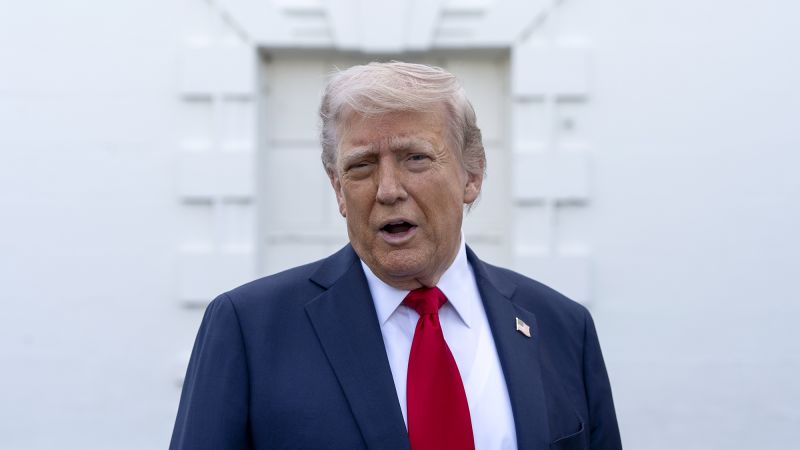Trump’s peace offer on Ukraine is generous to Russia, and may not even be enough for Putin
Imposing a deadline on a negotiation for a deal you desperately want is a risky tactic if your only move is to walk away.
President Donald Trump has threatened just this, and emphasized on Wednesday it is proving easier to make a deal with Russia than Ukraine. Yet that seems a perilous misreading of his own predicament. It is easier for Trump to pressure Kyiv, yes, because they are dependent on US aid and intelligence for their mere survival. But that does not mean Russia is more amenable to a deal. In fact, they are palpably dragging their feet.
This is where the gulf between a life in business deals and one steeped in geopolitical negotiation yawns desperately. Now, Trump is not in the world of real estate – he is not trying to get Putin to buy something. Trump is pushing hard and fast for the Kremlin to agree to terms to end the war that Putin has clearly divined will improve, not worsen, over time.
Trump applied pressure to Putin briefly on Thursday, posting “Vladimir: STOP!”, after Russian missiles targeted Kyiv, killing at least 12 people. But even the scolding used a friendly lexicon, and seemed as upset at the timing of the Russian attack as its casualties.
Russian President Vladimir Putin has publicly rebuffed the US and Ukraine’s now 44-day old offer of a 30-day, unconditional ceasefire. Instead, the Kremlin unilaterally declared a truce for Easter that lasted 30 hours and that Ukraine claimed they violated about 5,000 times. Both sides have accused the other of breaching an energy and infrastructure truce for March and April
This dabbling with ceasefires has left a huge question mark over whether diplomatic agreements will be honoured, or can deliver. Ukraine’s allies point to the Easter truce – unilateral, brief, sudden – as proof the Kremlin think ceasefires are for re-equipping, and negotiation is what happens when you are biding time so you can later pursue your military goals.
The larger problem with Trump’s proposed deal is it is not publicly known what he expects Moscow to cede. A lasting pause in the fighting does seem, on the evidence of the past month, to be a stretch. A wider US-Russia détente may be desired by the White House. But without an enduring settlement for Ukraine, this would result in a long-term fissure in the Transatlantic alliance and even NATO. That would likely spook many establishment Republicans, countless Americans, damage the dollar, and US economic and geopolitical standing. These are real costs that would outweigh the gain of a likely brief make-up with the Kremlin.
Trump’s second problem is it is also unclear – in public so far – what he expects President Zelensky to cede. He told Zelensky in his post on Wednesday to “GET IT DONE”, but it is unclear what the IT is.
Trump was specific he was not demanding Kyiv recognise Russia-annexed Crimea as part of Russia, as has been reported (Ukraine’s constitution prohibits such an act, as it also demands Ukraine move to become part of NATO – an ambition Trump may also ask it to abandon.)
The proposed Trump deal, it seems, may ask Ukraine to accept a freezing of the frontlines, and perhaps American recognition of Crimea as Russian. But both concessions are of limited utility.
Crimea is a peninsula, linked to Russian-occupied parts of Ukraine yet separated from Russia bar a precarious bridge. European and Ukrainian sanctions would continue to isolate Crimea after any peace deal, and both Europe and Kyiv have made it clear they won’t accept its recognition as part of Russia – the altering of land borders by force. With this, Trump is offering Putin a frail fig leaf of respectability. But that is not, in of itself, surely enough?
So what of deal that freezes the frontlines? This may also not be in Moscow’s interests. Putin’s recent bid to drag out the diplomatic process suggests the Kremlin thinks its best battlefield days may lie ahead of it. The oil price may continue to drop, and Moscow may feel manpower crunches ahead. Yet these problems are minor compared to Kyiv’s recruitment issues and the likely dent in its funding when Biden-era cash runs out next year.
The Kremlin’s other vague red lines, voiced by various officials, will be as disruptive to a longer peace. They don’t want European troops acting as a peacekeeping or reassurance force on Ukrainian soil – an idea quite advanced in its planning, that echoes the early version of a peace plan proffered by US envoy Keith Kellogg when he was a private citizen. They are against continued foreign aid to – and intelligence sharing with – Ukraine. Russia wants sanctions lifted up front, ideally. None of this is compatible with wider security concerns on the continent, and will force the Europeans, and Ukraine, to go it alone. That too does not bring a peace deal.
The overriding problem is Putin thinks time is on his side and Trump has repeatedly said the clock is ticking. These two contrasting positions will not yield a lasting deal. The Kremlin has perhaps wisely ascertained it can, over months, hive off tiny concessions from the White House, and slowly build a geopolitical picture that is more in its favour. Consider the first 90 days of Trump’s presidency and how far the world has already changed in Moscow’s favour.
At each crunch point, Moscow also sees Trump turn on Zelensky. The Kremlin see little or no consequences for it breaching the energy – or its own unilateral – ceasefire. It sees a vividly impatient US president, whose team are often loose with the facts, and whose key envoy, Steve Witkoff, struggled to name the regions of Ukraine under occupation in a recent interview with Tucker Carlson. All are also only partially under Russian occupation.
The longer Moscow talks, the better the deal seems to get. The longer it fights, the better the battlefield will likely also get. There is every incentive for the Kremlin to keep diplomacy alive, even to sign on to an early, chaotic deal it may later renege on. But there is no reason to believe it wants talks that actually resolve the war, or fighting to stop either.







